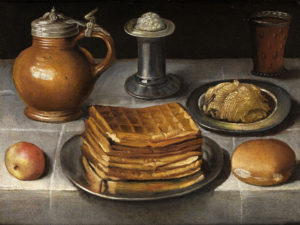Gather round the table: tradition would have us eat waffles today. It’s a tradition around which folks generally rally with pleasure, for is there anything quite like a waffle? So simple, yet so delicious. And the reasoning behind our waffle-eating today is such a roundabout and circuitous one. Allow me to tell you the story:
It begins with the Feast of the Annunciation, which typically is on the 25th of March. But, when the feast coincides with Holy Week (this year it fell on Palm Sunday), Holy Week takes precedence and the Feast of the Annunciation is moved to the Monday after the Second Sunday of Easter, which is where we’re at today. The Feast of the Annunciation is our first step toward the annual celebration of Christmas, for it marks the day that the archangel Gabriel visited Mary to deliver the news that she was to bear a child, a son, and that that child would be the light of the world, the son of God. March 25th is precisely nine months to the nativity.
It is traditionally a day of contemplative prayer, but early in the history of this holiday, it took on a nickname from its connection to Mary: Lady Day. Indeed, many people still call the Feast of the Annunciation Lady Day. And here’s where the waffles come in: In Sweden, the day is called Vårfrudagen, which essentially translates to “Our Lady Day.” But Vårfrudagen, in some Swedish dialects, is awfully close in both spelling and pronunciation to Våffeldagen, which translates to “Waffle Day.” Swedes, as a result of this misunderstanding, have for centuries been eating waffles on Lady Day. It’s a tradition that has spilled over to wherever Swedes have left their mark, this annual excuse to eat waffles at any time of day on Vårfrudagen––breakfast, lunch, or dinner. The waffles in Sweden today are typically served with whipped cream and lingonberries or cloudberries. However and whenever you serve them (Waffles for dinner? Yeah!), enjoy. Do not be afraid. Perhaps you, too, have found favor with God.
Image: “Stillleben mit Zinntellern, Steinkrug und Waffeln” (Still Life with Pewter Plates, Stein and Waffles) by Georg Flegel. Oil on wood, 17th century [Public domain] via Wikimedia Commons.
